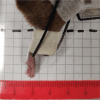Fixation method influences FLASH skin sparing in an in vivo leg model
- PMID: 40762144
- PMCID: PMC12340987
- DOI: 10.2340/1651-226X.2025.43972
Fixation method influences FLASH skin sparing in an in vivo leg model
Abstract
Background and purpose: The FLASH effect, where ultra-high dose rate elicits a favourable normal tissue-sparing, has been shown in several preclinical studies. Study setup differences, for example fixation methods that affect blood flow, can influence radiation response but are unexplored for FLASH. This study compared FLASH's acute skin-sparing effect with two fixation methods: a glued fixation (no blood flow restriction) and taped fixation (slight blood flow restriction). Patient/material and methods: Female CDF1 mice were irradiated on their hind foot using a glue-fixation or tape-fixation method. Glue-fixated mice were only taped during the glueing procedure and had a 10-min unrestricted period afterwards before irradiation, while tape-fixated mice were taped shortly before and throughout irradiation. Mice received single-dose irradiation (19-58 Gy) with either conventional dose rate (CONV, protons 0.06 Gy/s, electrons 0.16 Gy/s) or FLASH (electrons, 223-233 Gy/s). Differences in skin toxicity were analysed.
Results: CONV-treated tape-fixated mice required a 16-17% higher dose to induce skin toxicity relative to glued mice for both protons and electrons. Meanwhile, the fixation method did not affect FLASH-treated mice. The resulting electron FLASH-sparing effect was reduced by 18% due to the shift in radiosensitivity for CONV-treated mice.
Interpretation: CONV-treated tape-fixated mice were more radioresistant than the glue-fixated mice, consistent with the expected response to mild hypoxia. FLASH-treated mice were unaffected. These findings demonstrate the impact of fixation and, in turn, oxygen level on the differential CONV versus FLASH skin response. The results highlight the importance of minimal systemic influence on animals during FLASH studies.
Conflict of interest statement
The authors declare the following financial interests/personal relationships, which may be considered potential competing interests: The study presented in this manuscript was supported by Varian, a Siemens Healthineers Company. BSS and PRP are co-inventors on a patent application (application no. 63257211 and EFS ID 44064136). The remaining authors declare that the research was conducted without commercial or financial relationships that could be construed as a potential conflict of interest.
Figures





Similar articles
-
A Feasibility Study of Preclinical Ocular X-Ray FLASH Radiation Therapy.Int J Radiat Oncol Biol Phys. 2025 Jun 28:S0360-3016(25)04521-3. doi: 10.1016/j.ijrobp.2025.06.3883. Online ahead of print. Int J Radiat Oncol Biol Phys. 2025. PMID: 40588067
-
Anesthetic Oxygen Use and Sex Are Critical Factors in the FLASH Sparing Effect.Adv Radiat Oncol. 2024 Mar 13;9(6):101492. doi: 10.1016/j.adro.2024.101492. eCollection 2024 Jun. Adv Radiat Oncol. 2024. PMID: 38711960 Free PMC article.
-
Whole Abdominal Pencil Beam Scanned Proton FLASH Increases Acute Lethality.Int J Radiat Oncol Biol Phys. 2025 Feb 1;121(2):493-505. doi: 10.1016/j.ijrobp.2024.09.006. Epub 2024 Sep 18. Int J Radiat Oncol Biol Phys. 2025. PMID: 39299552 Free PMC article.
-
The Black Book of Psychotropic Dosing and Monitoring.Psychopharmacol Bull. 2024 Jul 8;54(3):8-59. Psychopharmacol Bull. 2024. PMID: 38993656 Free PMC article. Review.
-
Systemic pharmacological treatments for chronic plaque psoriasis: a network meta-analysis.Cochrane Database Syst Rev. 2021 Apr 19;4(4):CD011535. doi: 10.1002/14651858.CD011535.pub4. Cochrane Database Syst Rev. 2021. Update in: Cochrane Database Syst Rev. 2022 May 23;5:CD011535. doi: 10.1002/14651858.CD011535.pub5. PMID: 33871055 Free PMC article. Updated.
References
-
- Kim MM, Verginadis II, Goia D, Haertter A, Shoniyozov K, Zou W, et al. Comparison of FLASH proton entrance and the spread-out Bragg Peak dose regions in the sparing of mouse intestinal crypts and in a pancreatic tumor model. Cancers (Basel). 2021;13:4244. 10.3390/cancers13164244 - DOI - PMC - PubMed
MeSH terms
LinkOut - more resources
Full Text Sources

